With a rising population, urbanization, and an increasing number of vehicles on the road, transport systems are facing several challenges. The population is growing, and city infrastructure is becoming increasingly complex. Bus transport alone cannot fulfill the personalised needs of commuters today. Dynamic solutions such as Bus on-demand services offer customised services using technology. Tech-aligned services are efficient, making travel easier.
On-Demand Buses Through Mobile Apps
On-demand buses enable transportation through on-demand bus apps, adapting routes in real-time based on demand. A 2025 survey report indicates that the global bus market, encompassing both public and on-demand buses, is expected to grow significantly from USD 51.27 billion in 2024 to USD 116.99 billion by 2035. This growth is due to rising urbanization, increased population, and the shift to sustainable transport systems.
The worldwide experience with using bus on-demand systems is a valuable step toward sustainable urban transport solutions. Cities facing burgeoning populations and acute environmental conditions find this new-age strategy a chance to improve public commute services.
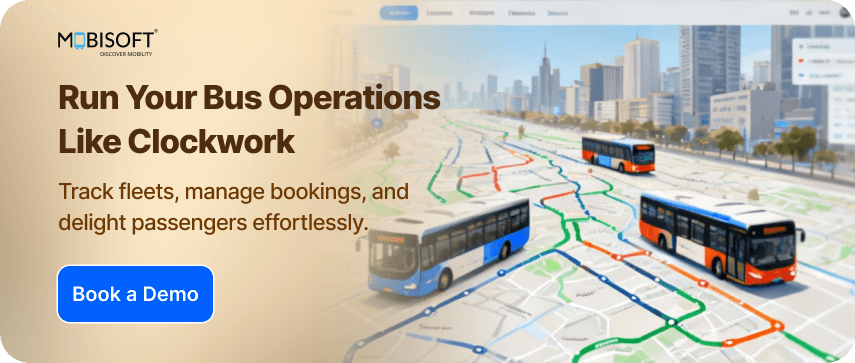
The Mechanism of Bus On-Demand Services
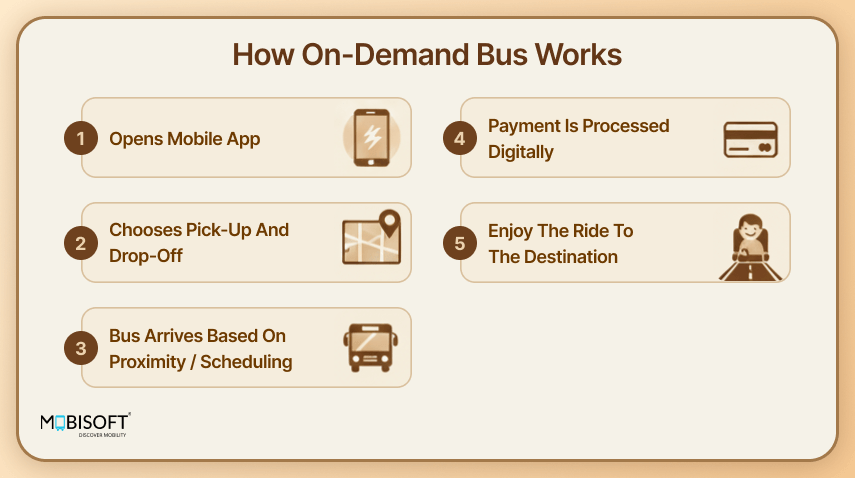
Bus-on-demand services combine technology and operational planning to provide efficient urban transportation. The smooth working of these services involves:
App-Based Requests
- Riders download a dedicated on-demand bus booking app to create their profile and request rides.
- The app's interface is intuitive, with elements of ride tracking and payment handling.
Routing Algorithms
- On-demand bus technology thrives on advanced routing algorithms.
- The algorithms work with real-time data, including passengers and traffic, and determine the best routes.
- The result is a smart on-demand bus solution that minimizes waiting times and maximizes occupancy.
User Journey
- Users can request rides and wait for their pick-up at virtual stops shown in the app.
- These virtual maps are placed strategically to offer the services to the maximum users possible, resulting in shorter travel time.
- Users can check driver ETAs as well as the approximate time of reaching the destination.
Technology Integration
- Users can track their driver’s location, which is enabled through GPS systems.
- The ability to monitor location in real-time, also during the journey, makes it reliable and trusted by the users.
Operational Models
- Bus on-demand services can vary depending on the needs of the users.
- Many offer pooled rides for more affordable and efficient commutes, office buses, for example. Others offer a personalised commute with virtual stops.
- This room for customisation helps companies offer tailored services, so the users can enjoy safe and comfortable rides.
Fleet Types
- The size of the vehicle can differ significantly depending on demand and population density.
- Most services employ minibuses or shuttles, which are best suited to on-demand services because of their effectiveness within urban settings.
Learn how our bus fleet tracking solutions help operators monitor performance, ensure route accuracy, and enhance real-time visibility for passengers.
Benefits of Bus On-Demand Services
Self-driving, automated bus on-demand services offer many benefits that can greatly enhance urban transport:
Increased Accessibility
On-demand bus solutions for cities can attend to populations that have been neglected for many years, and most significantly, the disabled and the elderly. Through the provision of personalized service that caters to specific needs, cities can enhance accessibility to people who cannot access the traditional routes of the buses.
Reduction of Traffic Congestion
By providing ride shares and best route planning with real-time demand, smart on-demand bus solutions can significantly decrease traffic congestion. Research proves that better public transport can decrease car travel, thus decreasing overall traffic. However, these services themselves contribute to some part of the traffic, especially during busy hours.
Enhanced Public Transit Efficiency
The adaptability of on-demand bus systems for fleet operators enables a higher return on resources. Vehicles can be dispatched based on actual-time demand instead of by schedule, resulting in higher rider satisfaction and system efficiency overall.
Cost-Effectiveness
On-demand bus service pricing adoption can significantly reduce costs to municipalities and transit agencies. There is evidence to show that, when done efficiently, populations benefit financially compared to their previous fixed-route service.
Improved First and Last-Mile Connectivity
On-demand transportation fleet management provides a very attractive solution to commuters with their homes far from pick-up points. This is especially useful in neighborhoods that cannot be served by fixed routes by buses.
Service Coverage Flexibility
On-demand bus transport can readily respond to varying demand and service areas, adjusting service hours in real time. It ensures that public transport is always available to the people.
Integration with Other Transportation Modes
Companies combine on-demand bus service technology and multiple transport ways, ensuring that the experience is smooth. This multimodality improves rider convenience and aids in the growth of public transport usage.
Environmental Impact
Electric on-demand buses run on electricity, which contributes to sustainability. It is one of the most beneficial aspects of some bus on-demand services. Most passenger travels twice each day, which results in significant CO2 emissions. Given the number of commuters each day, running on electricity helps the planet greatly.
Discover how an advanced on-demand bus booking system simplifies scheduling, booking, and fleet management for operators.
User Experiences
User feedback consistently indicates improved ride experiences when they use bus on-demand services. A study reveals that riders enjoy the lower waiting times and increased convenience that result in much higher satisfaction. Such positive feedback casts a favorable light on the service providers, facilitating broader utilization of public transport.
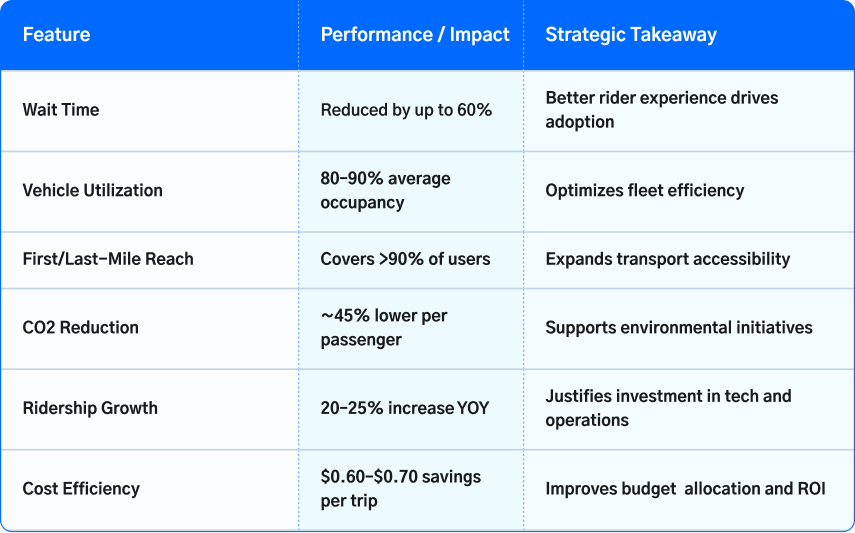
Explore how smart bus management software improves fleet performance and operational efficiency in on-demand systems.
Navigating the Hurdles of On-Demand Transit
Although bus-on-demand services offer a multitude of advantages, they also pose challenges that cities and transit operators must adeptly manage:
Infrastructure Requirements
A friendly interface is crucial for users to accept on-demand bus systems. Governments should support and invest in building applications and virtual stops to help facilitate the use of on-demand bus services.
Initial Investment Costs
The shift to an on-demand bus service for cities requires substantial investment. Transit agencies and cities need to mobilize finances to design technologies, purchase vehicles, and train personnel.
Data Privacy Concerns
The collection of user data through on-demand bus app development raises privacy and security concerns. Transit organizations should implement strict policies to protect user data.
Service Reliability
The collection of user data through on-demand bus app development raises privacy and security concerns. Transit organizations should implement strict policies to protect user data.
Equity Issues
While these services are not cheap, they need to be made available to the masses. Efficient use of technology will help in taking it to the common citizens, who rely on public transport for work and outings.
Resistance from Traditional Operators
Implementation of on-demand bus transport can face resistance from existing operators and workers’ unions. Transparency and cooperation are required to mitigate conflicts.
Continuous Feedback Mechanisms
Embedding continual feedback channels is essential to understand citizens’ experiences and improve bus on-demand services continuously. Citizen engagement helps customize transit solutions effectively.
Learning from Failures
Some cities have faced missteps with on-demand bus systems. For instance, drivers have failed with poor planning or a lack of interest among their customers. Such cases manifest the crucial necessity of having extensive studies, vigorous citizen involvement, and scalability while planning new transport paradigms.
Cities can optimize planning and scalability with our transportation logistics solutions designed to enhance coordination and fleet management for on-demand bus services.
Case Studies of Successful Bus On-Demand Programs
Examining successful case studies provides invaluable insights into effective bus on-demand programs:
Dubai's RTA Bus on Demand Service
- The Roads and Transport Authority of Dubai introduced its bus on-demand service in 2019.
- Many users, especially in populous areas, have appreciated the RTA's initiative, as shown by usage statistics. Working in real-time, the app’s algorithm has made traveling much easier.
- Reports confirm that usage levels have exceeded expectations, with user reviews reinforcing the service's unparalleled convenience.
Dallas On-Demand Program
- The Dallas-based app synchronously integrates multiple transportation services, including on-demand.
- It greatly increased accessibility to riders, particularly students, by facilitating easy trip planning and smooth payments.
- Statistics show that, after its introduction, ridership increased significantly, reflecting the app's significant impact on public transport usage.
Microtransit service in the UK
- A microtransit service mobile app in North Lincolnshire was created specifically to serve rural communities that lacked traditional routes.
- It was able to replace the obsolete dial-a-rides with a tech-savvy platform that enables individuals to make their bookings with ease.
- Stretching across a large area, the service uses fixed-route on-demand optimization to improve its service.
- As a result, rider satisfaction reportedly increased significantly with the service improvement being the reason.
Microtransit in Rural Areas
- Many of its microtransit projects were designed within rural communities to fill the gap in accessibility that is present with traditional services.
- By using technology to facilitate on-demand requests, such programs balance local distinctiveness with sustainability.
Key Performance Indicators (KPIs)
Setting up KPIs that clearly define a project’s success is essential. Factors like user satisfaction, Usability, buffer time, ease of payment, and overall efficiency greatly help in understanding the performance.
Emerging Innovations Shaping Urban Mobility
The future of bus on-demand services is poised for further innovation and transformation:
Autonomous Vehicles
The integration of autonomous vehicles with on-demand bus systems can transform the sector. Vehicles will decrease operating costs while enhancing service efficiency, specifically within the confines of a city.
AI and Machine Learning
The use of artificial intelligence and machine learning technologies can improve predictive algorithms that are utilized to route and make demand forecasts. Such capabilities enable on-demand bus service technology to better prepare and respond to commuters' demands.
Expansion in Low-Density Areas
The on-demand public bus service for urban centers is destined for success within rural communities or sparsely inhabited regions, occupying interstices between public transport services. Expansion is likely to reach basic mobility solutions throughout underserved regions.
Partnerships with Tech Firms
Partnerships with tech companies will drive the development of innovative on-demand bus app development experiences. Streamlined payments and enhanced app functionality will improve user interaction.
Smart City Initiatives
Smart city initiatives will redefine the future of urban mobility. Cities that employ the latest technologies to manage their transportation assets will observe that smart bus on-demand solutions evolve organically into wider urban mobility planning.
Emerging Technologies
New technologies such as on-demand bus services powered by electricity and pay-by-phone systems will make bus on-demand systems even more compelling. These technologies increase operating efficiencies and form the cornerstone of sustainable urban transport.
Learn how operators are improving efficiency and achieving better ROI from bus tracking systems through AI-driven route optimization and analytics.
Driving the Future of Urban Transit
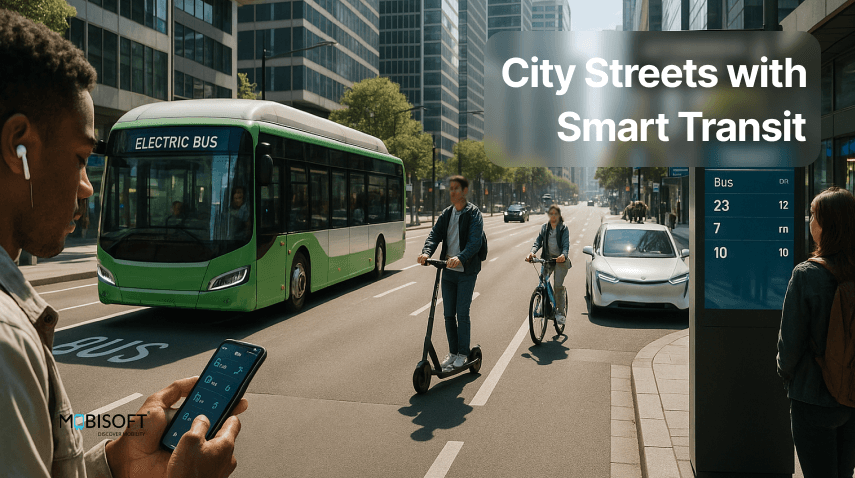
On-demand bus services create a very essential connecting thread towards the vision of integral urban transport. On-demand bus services hold a variety of pros while catering to the vital mobility needs of big cities. Flexibility, mobility, and responsiveness of on-demand bus services constitute a vital component towards optimizing public transport globally.
With local governments and service providers considering the addition of such services, a citizen-led open architecture based on public consultations shall be required. By promoting innovation and listening to the needs of travelers, public transport can turn into a sustainable offering that caters to the demands of contemporary urban citizens.
The future of bus on-demand systems for fleet operators is promising. But the implementation is feasible with the support of people, transport associations, and municipalities. Together, they can plan a public transport system that is responsive, efficient, and accessible. Local transport planning should be involved by organizations for them to actualize this new transport system, which will open a gateway towards future sustainable cities. Passenger security holds significant importance in the realm of adoption. Explore the topic of passenger safety within on-demand transport and discover how shared mobility applications are incorporating intelligent safety features.
Passenger security plays a crucial role in adoption. Read about passenger safety in on-demand transport and how shared mobility apps are integrating smart safety features.
Key Takeaways:
- On-demand bus service flexible public transport system that uses technology. The commuter can ask to change routes and even destination, making it a great alternative to bus transport.
- Mobile apps, global positioning system tracking, and sophisticated algorithms of routes facilitate ride requests, live tracking, and best routes, establishing trust and reliability among users.
- Services can range from collectively pooled trips to personalized virtual stops using minibuses or shuttle service commensurate with urban density and demand profiles.
- Dubai, Dallas, and Lincolnshire have shown successful bus on-demand service adoption, improving accessibility, ridership, and transit efficiency.
- On-demand transit enhances the access of marginalized populations, including the elderly and people with disabilities, thus rectifying shortcomings inherent within traditional bus service.
- Real-time Routing reduces congestion, optimizes the usage of vehicles, and optimizes the first and last mile connectivity of commuters.
- Shared transport can reduce the expense of municipal transport and lower CO2 emissions per passenger compared with private transport or traditional fixed-line buses.
- Success will entail investments made into infrastructure, data protection measures, quality of service, fair access, and integration with incumbent players.
- Citizen feedback helps improve on-demand bus systems, prevent failures, and scale effectively.
- Integration of autonomous vehicles, AI-based routing, rural expansion, and smart city partnerships will shape next-generation smart on-demand bus solutions.
FAQs: Bus On-Demand Services
Q1: How can on-demand bus services truly improve first- and last-mile access to cities?
A: Fixed-route services are limited to specific roads and areas, carrying passengers along predetermined paths. On-demand buses aim to drop riders as close as possible to their desired locations, minimizing personal vehicle usage and saving time.
Q2: Why is an on-demand bus a greener alternative to a traditional bus?
A: Traditional public buses often waste fuel running empty miles on fixed routes. On-demand bus transport maximizes efficiency by reducing these empty runs, lowering CO2 emissions per passenger compared with private cars and standard bus services.
Q3: Why don’t on-demand services operate in some areas despite available technology?
A: The Success of bus on-demand systems for fleet operators depends on mobile apps, careful planning, scalable fleets, virtual stop infrastructure, capital investment, and citizen engagement. Cities lacking these foundational elements may experience slow adoption or operational inefficiencies.
Q4: How can on-demand bus systems make urban transport socially equitable?
A: On-demand bus solutions for cities can prioritize populations traditionally underserved by public transport, including the elderly, disabled, and residents of low-density areas. Flexible routes and pooled rides improve inclusivity and accessibility.
Q5: What can Dallas and Dubai teach other cities about scaling bus on-demand services?
A: Dubai’s RTA found that real-time routing through crowded areas maximized utilization. Dallas showed that offering multiple service options increases ridership. The key takeaway is that on-demand bus service technology must complement smart planning and user-focused design.
Q6: Are on-demand buses financially viable in the long run for cities?
A: Microtransit pilots demonstrate that on-demand bus fleets save operational costs compared to low-performing fixed routes. While startup costs are high, cost-effectiveness improves over time due to reduced empty miles and higher public transit utilization.
Q7: How can future technologies like driverless cars and artificial intelligence transform bus-on-demand services?
A: AI can anticipate demand patterns, reduce waiting times, and optimize vehicle deployment. Autonomous vehicles minimize labor costs and provide 24/7 service, enabling an entirely adaptive and scalable bus on-demand system.


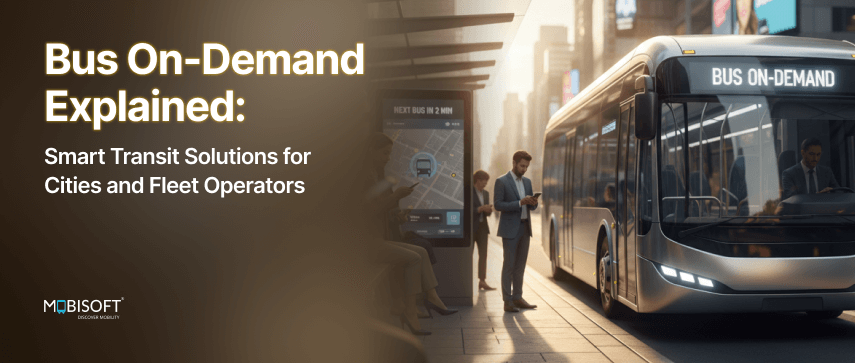


 September 8, 2025
September 8, 2025


